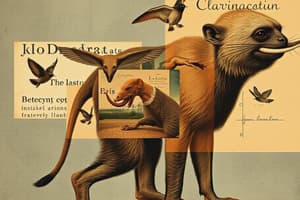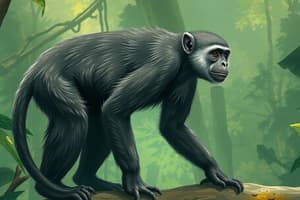Podcast
Questions and Answers
Classifying an animal as a 'pit bull terrier' is an example of what?
Classifying an animal as a 'pit bull terrier' is an example of what?
a common name
Which early scientist developed the system of classification that we use today?
Which early scientist developed the system of classification that we use today?
Linnaeus
In the scientific name Pongo pygmaeus, what does Pongo represent?
In the scientific name Pongo pygmaeus, what does Pongo represent?
genus name
Which scientific name for the ring-tailed lemur is presented correctly?
Which scientific name for the ring-tailed lemur is presented correctly?
The science of classifying and naming organisms is called what?
The science of classifying and naming organisms is called what?
Traits that are similar due to common adaptation, but not common descent, are called what?
Traits that are similar due to common adaptation, but not common descent, are called what?
Which of the following primates is more likely to be nocturnal?
Which of the following primates is more likely to be nocturnal?
Which of the following primates has a platyrrhine nose?
Which of the following primates has a platyrrhine nose?
Old World monkeys sometimes have a prehensile tail.
Old World monkeys sometimes have a prehensile tail.
All New World monkeys are arboreal, but Old World monkeys show a combination of arboreality and terrestriality.
All New World monkeys are arboreal, but Old World monkeys show a combination of arboreality and terrestriality.
Flashcards are hidden until you start studying
Study Notes
Primate Classification Key Concepts
- Common names, like "pit bull terrier," serve as informal labels for specific breeds and illustrate the concept of classification in the animal kingdom.
- Carolus Linnaeus developed the current system of biological classification, introducing binomial nomenclature in the 18th century.
- In the scientific name Pongo pygmaeus, "Pongo" represents the genus name, which groups organisms that are closely related.
- The correct scientific name for the ring-tailed lemur is correctly noted as Lemur catta following the conventions of italicizing and proper noun capitalization.
- Taxonomy is the branch of science dedicated to classifying and naming living organisms, providing a systematic framework for biodiversity.
- Analogous traits are those that arise through similar environmental pressures rather than common ancestry, highlighting adaptive similarities among different species.
- Lorises are a group of primates that are primarily nocturnal, adapting to life in low-light conditions.
- New World monkeys, distinguished by their platyrrhine (broad) noses, include species that inhabit the Americas.
- It is false that Old World monkeys possess prehensile tails; these traits are more commonly observed in some New World monkey species.
- True statement: All New World monkeys are arboreal, meaning they live in trees, while Old World monkeys exhibit a mixture of arboreal and terrestrial lifestyles.
Studying That Suits You
Use AI to generate personalized quizzes and flashcards to suit your learning preferences.




